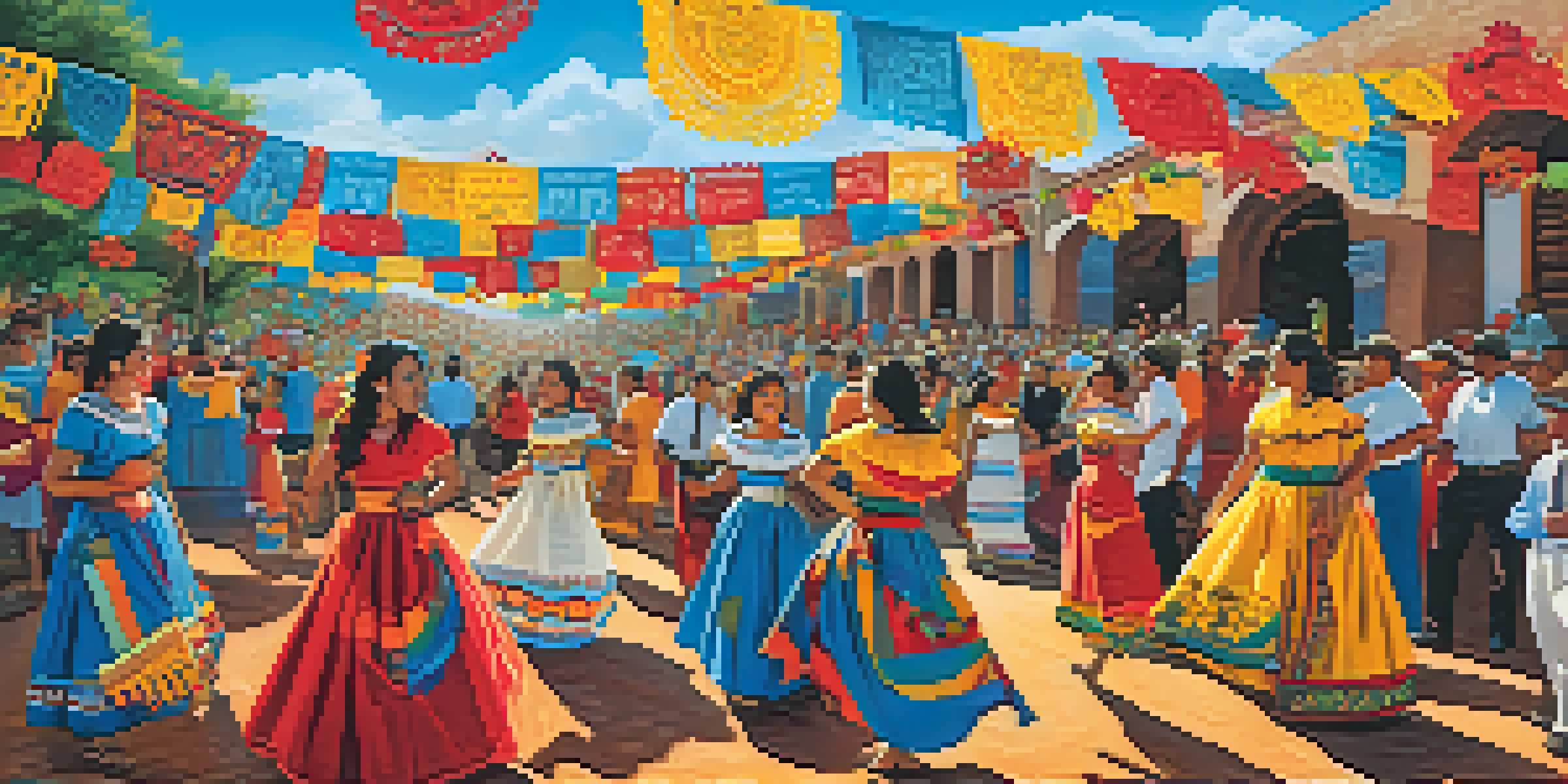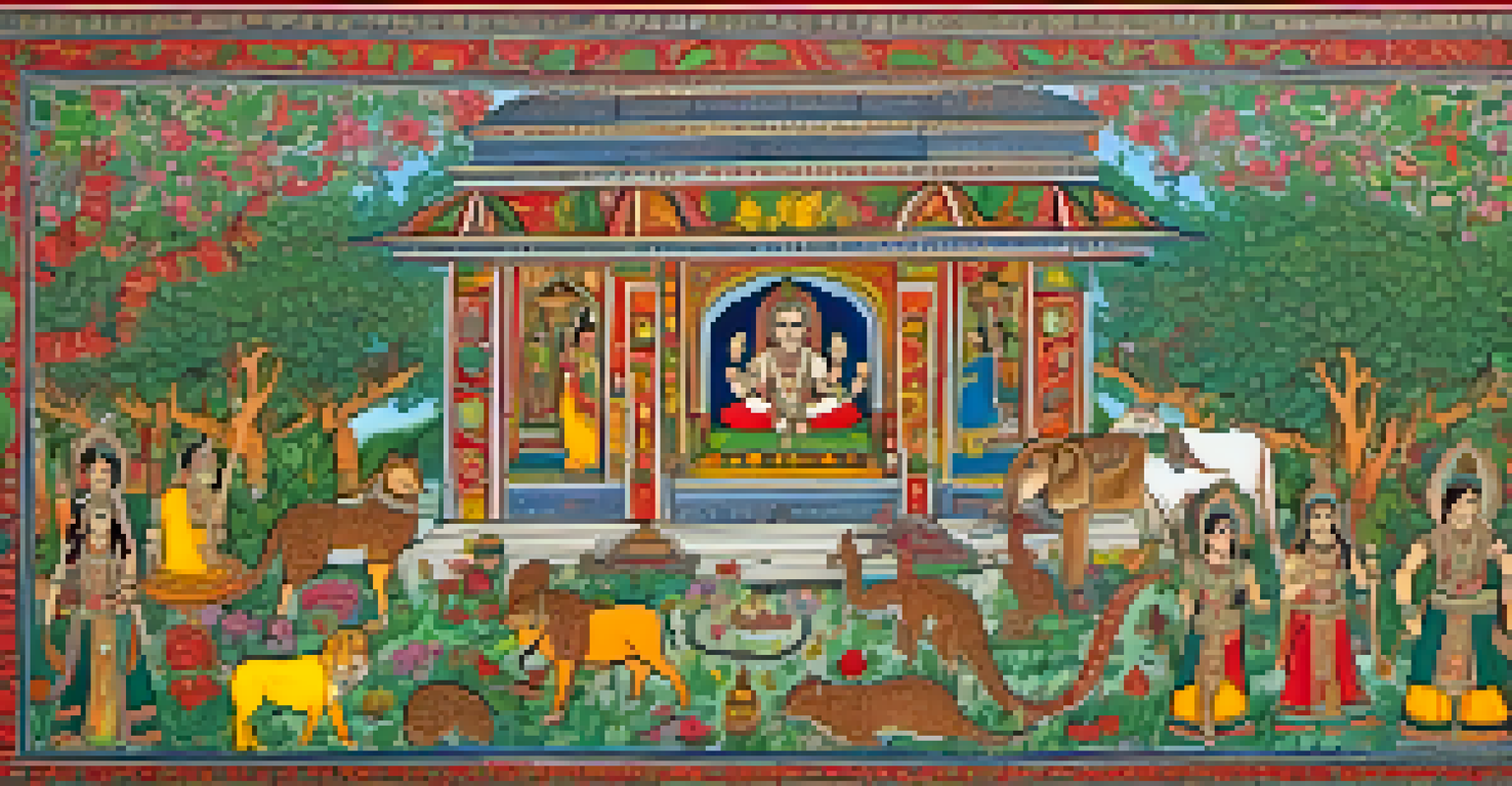Folk Art Traditions: Unique Painting Styles Around the World

Understanding Folk Art: A Global Perspective
Folk art is a captivating expression of cultural identity, representing the unique traditions and histories of communities worldwide. It encompasses various forms, including textiles, pottery, and of course, painting. These artworks often serve as a reflection of local customs, beliefs, and daily life, making them a rich tapestry of human experience.
Art is the most beautiful of all lies.
One of the beautiful aspects of folk art is its accessibility; it's created by people for people, often using locally sourced materials. This authenticity allows for a genuine representation of cultural narratives, as artisans infuse their personal stories and communal histories into their work. As a result, folk art not only preserves tradition but also breathes life into it.
From vibrant colors to intricate patterns, folk art can be both visually stunning and deeply meaningful. By exploring these unique painting styles, we gain insight into the diverse cultures that shape our world and foster a greater appreciation for the craftsmanship and creativity behind each piece.
Mexican Folk Art: The Power of Color and Culture
Mexican folk art is renowned for its vibrant colors and intricate designs, often reflecting indigenous heritage and cultural celebrations. One notable style is the use of papel picado, where colorful tissue paper is intricately cut to create stunning decorative banners. These artworks are not only visually appealing but also carry significant cultural meanings during festivals and celebrations.

Additionally, the Oaxacan painting tradition showcases the skill of local artisans who use natural pigments to depict scenes from everyday life, mythology, and history. These paintings often tell stories, capturing the essence of community and tradition. The bold colors and detailed imagery invite viewers to connect with Mexico's rich artistic legacy.
Folk Art Reflects Cultural Identity
Folk art serves as a captivating expression of cultural identity, showcasing the unique traditions and histories of communities worldwide.
Overall, Mexican folk art serves as a reminder of the importance of cultural identity. Each piece tells a story, allowing artists to communicate their heritage while inviting others to appreciate the beauty of their traditions.
Indian Madhubani Art: A Storytelling Canvas
Madhubani art, originating from the Mithila region of India, is a stunning example of folk art that beautifully blends mythology and nature. This intricate painting style is characterized by its vibrant colors, elaborate patterns, and the use of natural dyes. Traditionally, women would paint the walls of their homes with these designs during weddings and festivals, turning their living spaces into storytelling canvases.
Every artist dips his brush in his own soul, and paints his own nature into his pictures.
What sets Madhubani art apart is its ability to convey complex narratives through visual symbols. Each motif has a specific meaning, whether it represents deities, animals, or natural elements. This deep connection with storytelling allows viewers to engage with the artwork on a personal level, making it a unique form of expression.
As Madhubani art gains recognition globally, it continues to evolve while remaining rooted in tradition. Contemporary artists are experimenting with new mediums and themes, ensuring that this rich cultural heritage remains relevant and appreciated by future generations.
Chinese Folk Art: The Charm of Paper-Cutting
Chinese folk art is a treasure trove of unique styles, one of which is the ancient tradition of paper-cutting, known as 'jianzhi.' This delicate art form involves intricate designs created by cutting paper with scissors or knives, often used to convey good luck during festivals and celebrations. The beauty of paper-cutting lies in its simplicity yet profound symbolism.
Common themes in jianzhi include auspicious symbols like dragons, phoenixes, and representations of family and prosperity. These pieces are often displayed in homes as good fortune charms or given as gifts during special occasions. Each cut tells a story, making this art form a cherished aspect of Chinese culture.
Diverse Techniques Across Cultures
Various folk art forms, such as Mexican papel picado and Indian Madhubani art, illustrate the rich tapestry of human experience through distinctive techniques and storytelling.
As paper-cutting continues to thrive, modern artists are blending traditional techniques with contemporary styles, ensuring that this age-old practice remains alive. The delicate craftsmanship and rich symbolism of Chinese folk art serve as a reminder of the cultural values that endure through generations.
African Tribal Art: A Celebration of Community
African tribal art encompasses a diverse range of styles, each rich with cultural significance and storytelling. One prominent form is the vibrant painting styles found in regions like West Africa, where artists use natural pigments to create striking murals and textiles. These artworks often depict communal life, ancestral spirits, and cultural rituals, weaving a narrative that connects the community to its roots.
For instance, the Ndebele people of South Africa are known for their bold geometric patterns and bright colors, which adorn their homes and traditional clothing. These designs are not merely decorative; they represent identity, status, and the history of the community. Each brushstroke serves as a testament to the collective spirit of the people.
As African art gains international recognition, it's essential to honor its cultural origins and the stories behind each piece. Contemporary artists are now exploring new mediums while staying true to their heritage, ensuring that the vibrant traditions of African tribal art continue to thrive.
Indigenous Australian Art: A Connection to the Land
Indigenous Australian art is deeply rooted in the connection to land, culture, and spirituality. One of the most recognized styles is dot painting, which originated from the Pintupi people. This technique uses a series of colorful dots to create intricate patterns that tell stories of the Dreamtime—Aboriginal spiritual beliefs about creation and the world.
These artworks often reflect the artist's personal connection to their ancestral land, depicting landscapes, animals, and cultural symbols. The use of natural pigments and materials highlights the importance of the environment in Indigenous culture, emphasizing a profound respect for nature that has existed for thousands of years.
Preserving Heritage Through Art
Folk art plays a crucial role in preserving cultural heritage, allowing artists to share their stories and maintain connections to their roots.
Today, Indigenous Australian artists are gaining global recognition while continuing to honor their traditions. By sharing their stories through art, they educate others about their rich heritage and the importance of preserving their cultural identity.
Eastern European Folk Art: A Blend of Tradition and Innovation
Eastern European folk art is a vibrant blend of tradition and innovation, with unique painting styles that vary from country to country. For instance, Polish folk art, particularly the painted wooden eggs known as 'pisanki,' showcases intricate designs that celebrate seasonal festivals and cultural heritage. These eggs are often decorated with symbols representing fertility and rebirth, making them a cherished part of Easter celebrations.
Similarly, Ukrainian folk art features the beautiful Petrykivka painting style, which employs floral motifs and bright colors to create stunning decorative pieces. This art form, originally developed in rural areas, has gained recognition worldwide for its unique aesthetic and craftsmanship, blending tradition with contemporary influences.

As Eastern European folk art continues to evolve, artists are finding ways to merge traditional techniques with modern themes. This fusion not only preserves cultural heritage but also opens doors for new creative expressions that resonate with today's audiences.
Conclusion: The Timelessness of Folk Art
Folk art traditions around the world serve as a powerful reminder of our shared human experiences and cultural diversity. Each painting style tells a story, reflecting the values, beliefs, and histories of communities while celebrating their unique identities. By exploring these art forms, we not only appreciate the creativity behind them but also foster a deeper understanding of the cultures they represent.
As we embrace folk art, we recognize its role in preserving traditions and passing them down through generations. The vibrant colors and intricate designs are more than just visual delights; they are gateways to understanding the rich tapestry of human life.
In a rapidly changing world, folk art remains a timeless expression of community and creativity, reminding us of the importance of cultural heritage. So, whether it's through Mexican papel picado or Australian dot painting, these unique painting styles enrich our lives and connect us across borders.